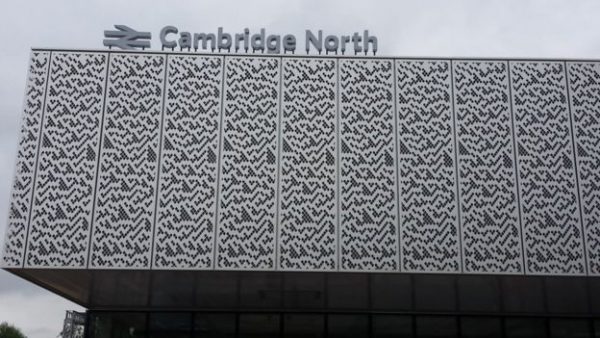Cambridge North is a brand new train station, and the building’s got a fab bit of cladding with a design ‘derived from John Horton Conway’s “Game of Life” theories which he established while at Gonville and Caius College, Cambridge in 1970.’

One problem: that’s Wolfram’s Rule 135, not the Game of Life. You can tell because of the pixels.
Rule 135 is a 1-dimensional automaton: you start with a row of black or white pixels, and the rule tells you how the colour of each pixel changes based on the colours of the neighbouring pixels. The Cambridge North design shows the evolution of a rule 135 pattern as a distinct row of pixels for each time step. Conway’s Game of Life follows the same idea but in two dimensions – a pixel’s colour changes depending on the nearby pixels in every compass direction.
Either way, it’s a lovely pattern. I suspect the designers went with Rule 135 instead of the Game of Life so that they’d get a roughly even mix of white and black pixels, which is hard to achieve under Conway’s rules.
Just in case gawping at train stations is your cup of tea, here’s a promotional video with lots of lovely panning shots of the design:
EDIT: James Grime has now also done a video, which can be seen here:
More information
Delayed £50m Cambridge North railway station opens on BBC News.
Cambridge North Station information from Atkins Group, the design consultancy responsible for the station building.
Press release from Greater Anglia trains.
The Game of Life: a beginner’s guide by Alex Bellos in the Guardian.
Brought to our attention by @Quendus on Twitter.
Dear Christian,
https://en.wikipedia.org/wiki/Rule_30
Let me assure you it is the correct answer. We turned the pattern through 45 degrees, distorted the pixels to a slightly elongated diamond and played about with the panel dimensions to ensure the maximum gathering of openings around eye level for the passengers using the station. What we liked most about rule 30 was it was as close as we could find to a “random” non repeating pattern.
Quintin Doyle, Senior Architectural Designer, Atkins.
Thanks for clearing this up – I guessed as much.
Notice that Wolfram’s Cellular Automaton Rule 135 is the color-inverted equivalent of Rule 30. During the day, the station looks like displaying Rule 135 and during the night like Rule 30, it is basically the same rule. Congratulations for such a beautiful design and opening.
Another nifty thing about rule30 (or rule135) is that it fits nicely on a wall, whereas Conway’s Life would have to fill space to be presented in similarly static manner. I suppose one could run it in a projector, but that’s hardly architecture anymore; or one might (golly) build it into LED tiling… But now you’ve got me wondering: what happens if rule30 is take as the first page of a Life run?